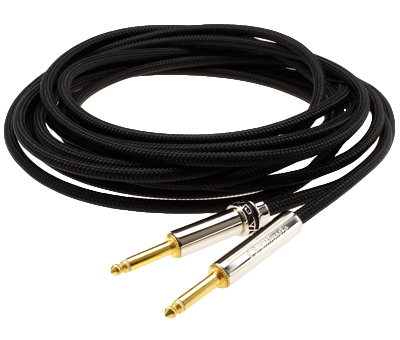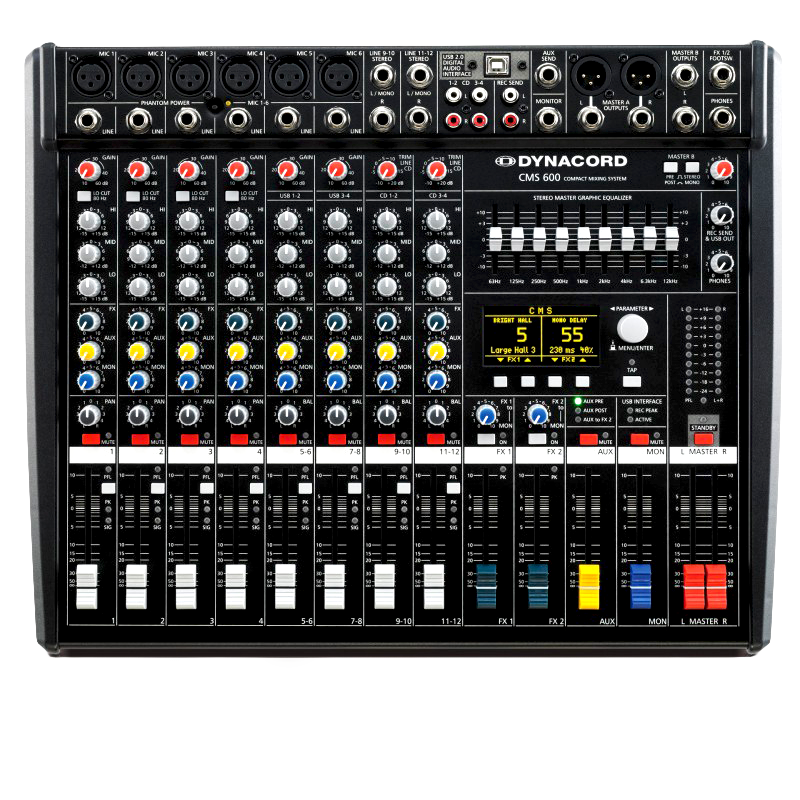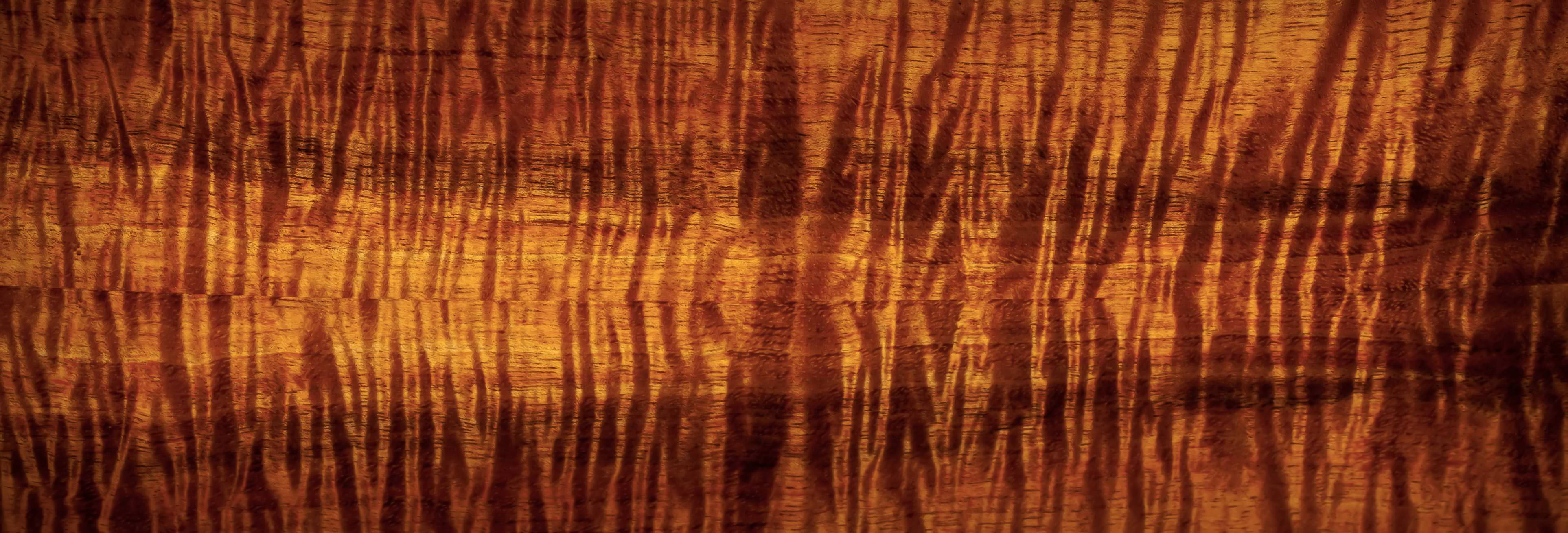Guitar Picks | Plectrums
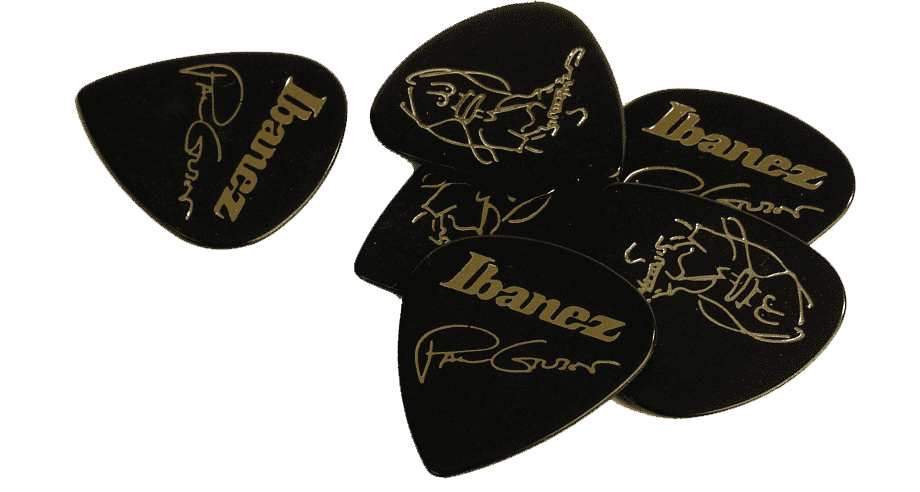
Guitar Picks | Plectrums
PICKS | PLECTRUMS

WHAT IS A GUITAR PICK
A guitar Pick - also referred to as 'Plectrum'; is a small acute isosceles triangle shaped tool, made from a variety of materials such as plastics, wood, Bone, glass and more.
A Plectrum is used to strum chords or individual notes on the guitar strings, producing particular & required sounds, with various styles & techniques.
STYLES & SHAPES
Pick shapes started with guitarists carving & shaping bone, shell, wood, metal, stone or ivory into shapes that worked well with grip & playing styles. Most of today's shapes were designed by the same company that released the first plastic pick in 1922 - D'Andrea Picks.
All Pick shapes are designed around grip, playability and sound projection.
Shape:
- Affects wearability and grip which affects playability
Edge Sharpness:
- Affects how easily the string glides off the surface of the plectrum.
Edge Bevel:
- The shape of the actual contour of the picks edge, can affect the strings resistance. Plucking upwards uses a different part of the bevelled contour than plucking downwards.
Thickness:
- One of the most important factors affecting the picks overall playability & tone.
SHAPES
Standard | "351" or "Heart Shape"
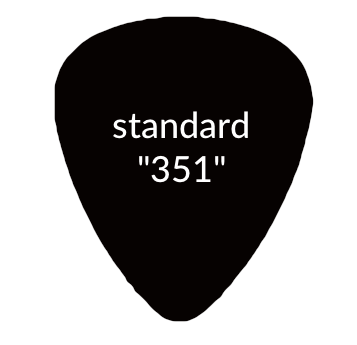
This is the 'Standard' and most commonly used shape in the list. Sometimes referred to as the "Heart shape" or "351" (manufacture no). These shapes come in different sizes and the tip is sometimes sharpened or bevelled for smoother playing.
Standard Sharp Tip
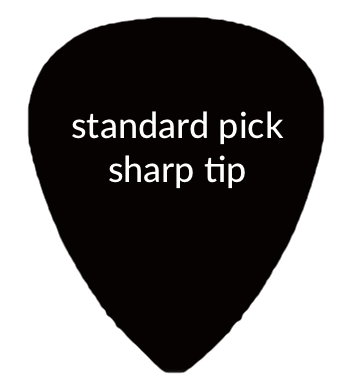
This shape is bigger than the Standard 351 and the tip is pointed. The Standard sharp tip merges the ease of grip that the Standard 351 offers, with greater control that the Jazz III offers. A nice for beginners.
Jazz III | "Little Jazzer"

This pick was designed for increased speed and precision Jazz players were looking for, but has since become a popular choice among many players. It is smaller than the standard 351 with a sharpened tip. These picks are normally designed with slightly heavier gauges.
Pointy

Not a particular favourite amongst most guitarists. The sharpened tip can be good for extra control, but can also be a little too sharp, and somewhat of an awkward shape for some player. This pick is also not the best when it comes to strumming technique.
Shark Fin

A multi purpose pick. There are two sides with different features: - One side is a rounded edge that gives normal playing abilities, while the wavy "Shark fin" edge can be used to create a range of interesting effects, enhancing sounds.
Teardrop Wide
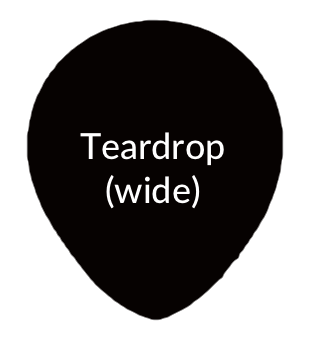
This shape design has derived from the original standard, but it has been modified to be more round and wide, while keeping the tip the same. This shape does allow for better grip.
Teardrop Thin
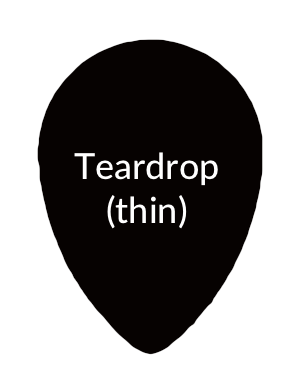
The design for this pick shape derives from the Jazz III; but with rounded form, narrowed in and the same sharpened tip of the Jazz III.
Triangle

This shape can be geometrically either a perfect triangle, or a triangle with rounded edges. This is a pick preferred by the likes of Bluegrass players who play a lot of chords and fast picking lines.
A nice advantage to this particular pick shape is that because of it having three identical corners; when one side is warn, you can just flip to the next corner.
OTHER STYLES
Finger Picks
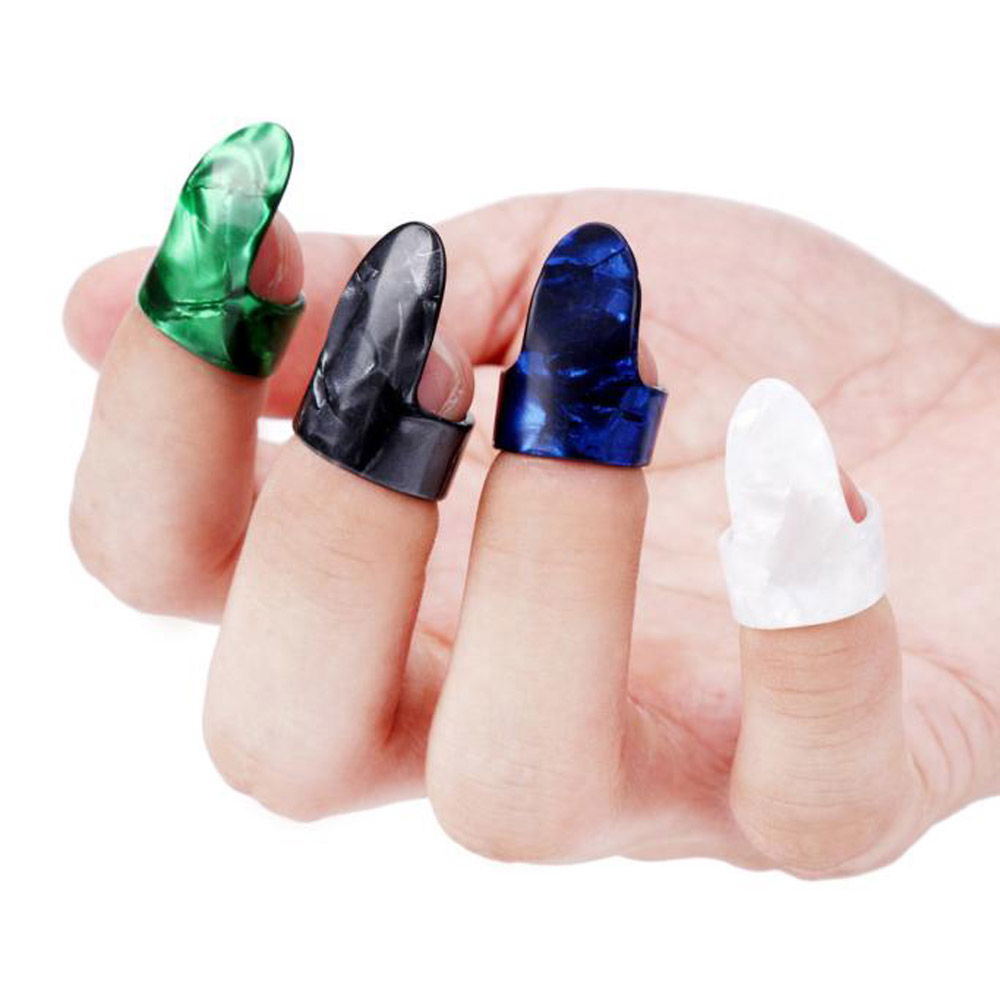
A Fingerpick is a type of plectrum most commonly composed of metal or plastic, and predominantly used for playing Bluegrass style banjo music. The fingerpick design is very different to that of the standard flat pick held between the thumb & finger. A fingerpick is designed to wrap around the tip of the finger, looking much like a child like false nail. They can be used on the four picking fingers alongside a thumb pick, or without. For different tones some players use metal on the finger picks with plastic thumb pick; or only use a thumb pick while strumming with fingertips; or just on the four fingers without a thumb pick. Experimenting with different styles will help you decide what you prefer. Classical guitarists, who traditionally use their fingernails to pluck the strings, may choose to use finger picks as an alternative to maintaining fingernails.
Thumb Picks
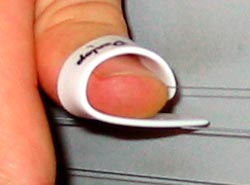
Much the same design as that of the fingerpick (wrap around finger tip), only slightly bigger, made specifically to fit the tip of a thumb. Adding finger picks or thumb picks to your strumming & picking techniques can make a big impact on your sound, and can really help you switch up your playing style & experiment with exciting new sounds. Available mainly in metal or plastic and used for a variety of strumming & picking techniques.
HOW DO PICKS/PLECTRUMS CONTRIBUTE TO THE OVERALL GUITAR SOUND/TONES
A plectrum generally has a pointed tip that, when adding a pick to your playing style, adds a brighter tone; unlike when using the soft, round finger tip that generally produces a more deepened tone.
Picks are also made from a variety of materials, all adding their own particular character to tone. Picks also offer a greater contrast in tone across different picking locations i.e. The difference when picking close to the bridge versus the neck in brightness is much greater than when using the finger tip.
PICK GAUGE | THICKNESS
Generally the thicker/heavier the gauge of the pick, the darker the sound produced while a lighter gauge pick would produce a brighter sound. The shape of the pick tip though, is the most influential on sound.
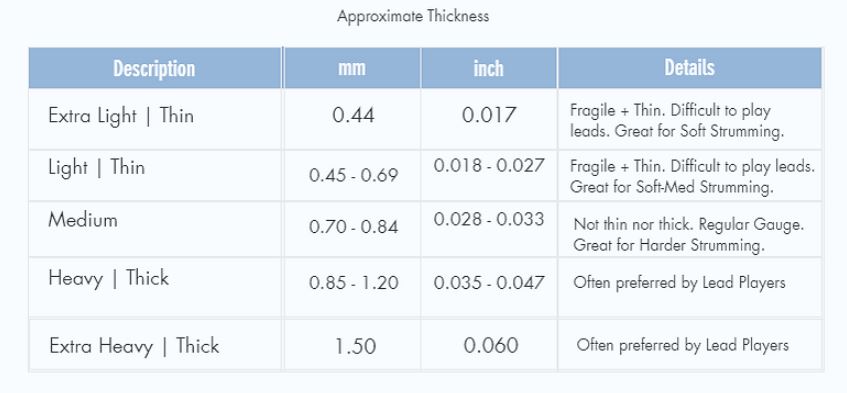
Every Manufacturer of guitar picks follows their own measuring gauge standards, so pick gauge specs can differ; however the table above displays a general overview on what you can expect in terms of pick thickness. Some manufacturers produce even heavier gauge picks, but these have been known to be difficult to play with; but there are some that prefer it. Again, it all boils down to personal preference.
PICK | PLECTRUM MATERIALS
The Material used to make picks is important and influences various aspects of a guitarists sound & style.
The materials and texture of a pick hosts a range of characteristics that need to be considered when selecting your pick:
* Flexibility:
- This will influence playability & style.
* Grip:
- Level of grip when it gets sweaty under hot stage lights etc.
* Durability:
- How strong the pick is and how long generally it would last for.
* Release:
- How easily does it glide off the string? 'Slippery'/'Smooth' picks give a cleaner more pure tone. 'Rougher' picks produce more colour in tone.
* Memory:
- How the material becomes worn down by the strings and shapes to the guitarists playing style.
There is a vast variety of materials that picks are made of, all hosting a range of particular features; but generally the most common forms of materials used are plastics, metals, wood and bone. Each type of material, contributing their own particular sound to the overall tone of the guitar.
Below is a general list of the current materials most commonly used to manufacture picks today:-
Tortoise Shell
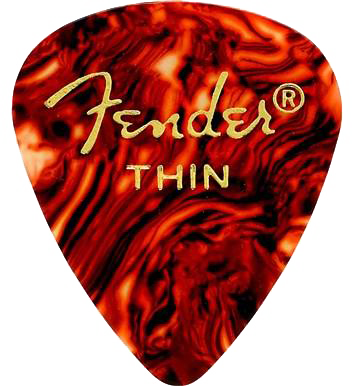
Tortoise Shell picks are made from the Hawksbill turtle; an endangered sea turtle, hence tortoise shell picks were banned around the 1970's. Often believed to be the "holy grail" of picks because of it's durability & "one of a kind" tone. Apparently it could last for years, could easily be reshaped with filing, and a natural tone that has been hard to replicate. They are illegal, but there are still some floating around today.
Celluloid - Plastic

Most commonly used pick today. Celluloid picks produce a balanced tone with a crisp, bright attack; making them great for Acoustic strumming. It provides crispness & upper range harmonics with a smooth feel as they glide across the strings. Celluloid picks come in a range of intricate & coloured designs - some designs made to look very similar to that of tortoise shell.
Nylon - Plastic
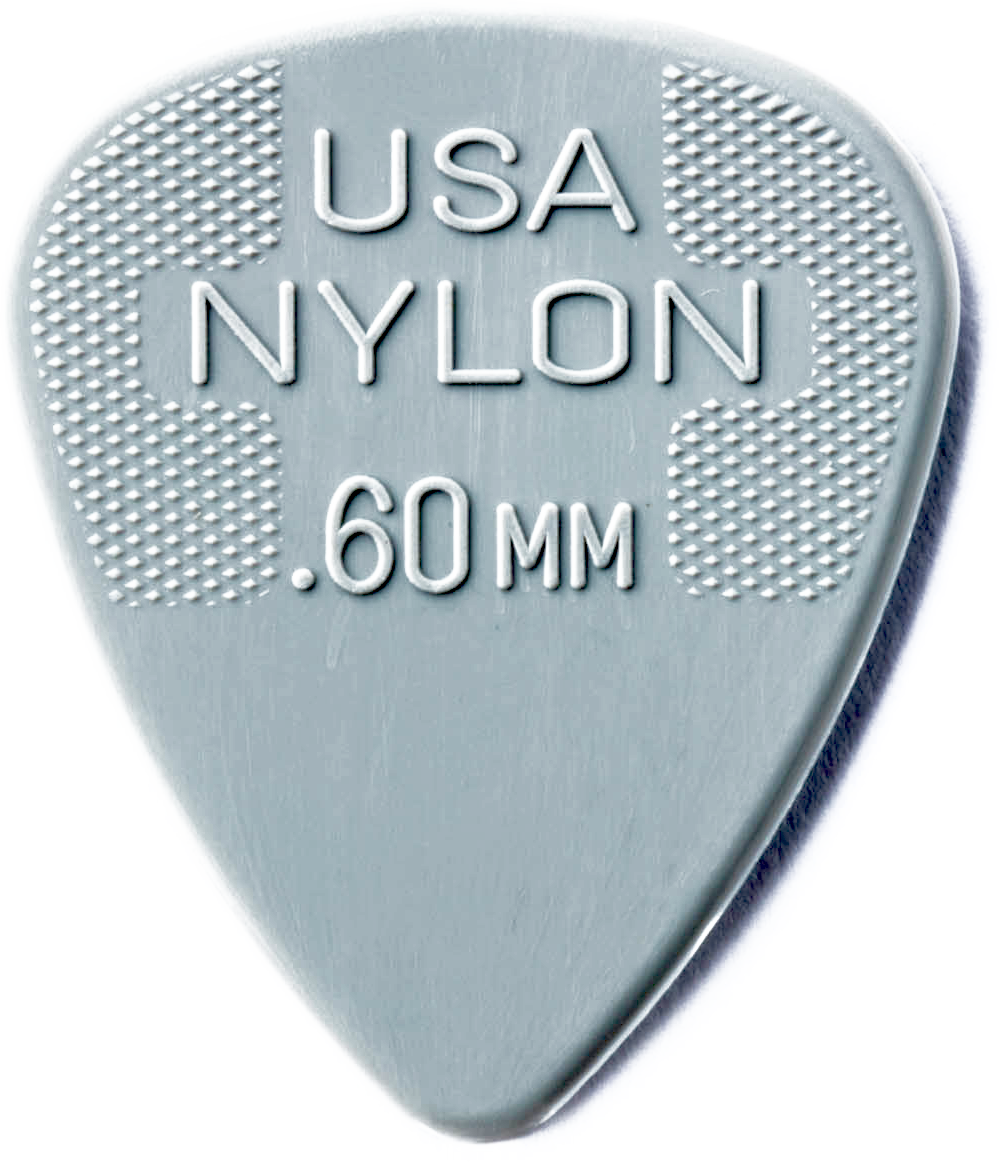
Nylon picks are often coated adding texture for better grip. Thin nylon picks can wear & shatter easily. Notable players of nylon picks is Gene Simmons & Jimmy Page, and possibly because of the flexibility nylon picks provide. Nylon is great for strumming chords, because it is flexible, but still stiff enough to pluck out individual notes or bass lines.
Delrin - Plastic

Delrin is a more modern pick material; a thermoplastic used in precision parts requiring stiffness, low friction & excellent dimensional stability. It has a matte, non-slippery finish and is most noted for durability and reliability. It also produces a slightly warmer tone.
Ultex (Ultem) - Plastic
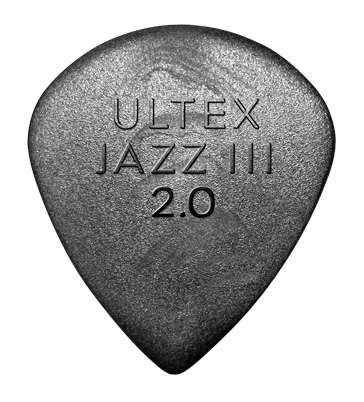
Ultex|Ultem is a high tech plastic that's extremely durable. They are generally lightweight; virtually indestructible, providing wide dynamic range compared to others. Character strengths for this pick material are: High strength at elevated temperatures, high modulus & broad chemical resistance. These picks overall are cost effective, durable, wear smoothly and produce a great tone.
Acrylic - Plastic
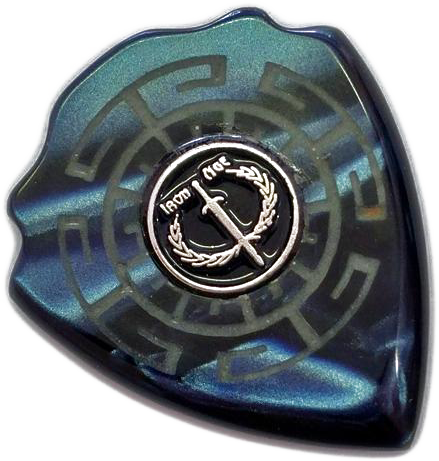
Acrylic is a tough, light, clear, seamless polymer with great resistance to impact & weathering. Acrylic is not brittle & does not yellow or crack. It renders a very full spectrum tonal range. Acrylic can also be heat tempered for strength and longevity.
Lexan - Plastic
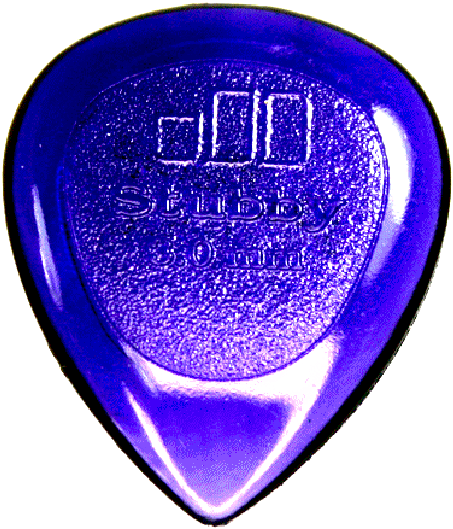
Lexan is a gloss, glass-like, very hard yet lacks durability type of material. Lexan is mainly used for thick & extra thick picks from around 1mm upward. Usually has a high-friction grip coating. Produces a more bright, clear tone.
Tortex - Plastic
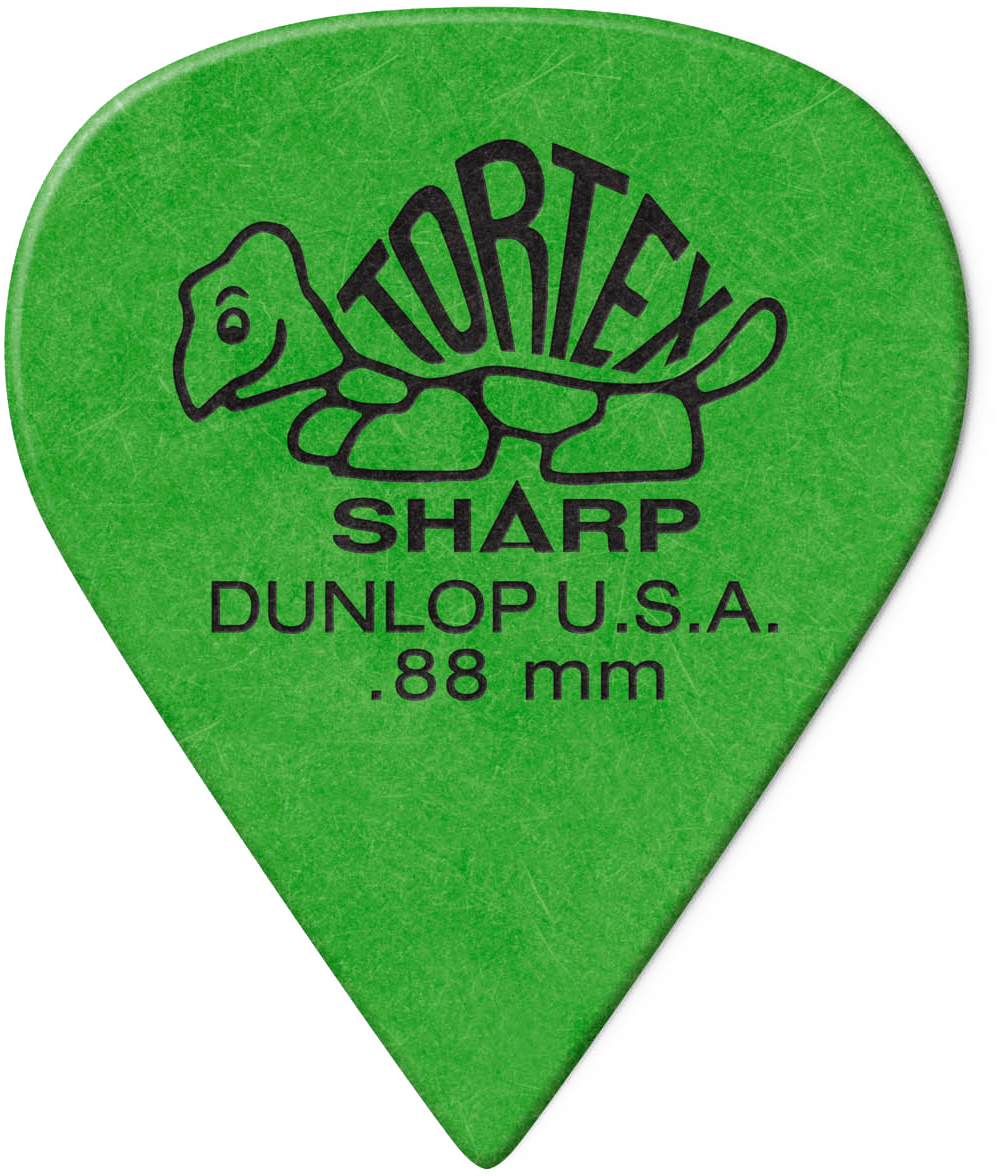
Some reckon Tortex is the next best thing to original tortoise shell, apparently feeling very similar in texture and sounding similar in tone. Tortex provides good attack, well-rounded tone with an overall nice feel. Notable famous players: Kurt Cobain, James Hetfield and Dimebag Darrell. James Hetfield prefers the 0.88mm green picks. Tortex picks are known for serious grip under hot conditions; when bought new, you may notice a powdery surface to them; this fades with time but this texture is directly responsible for adding extra grip abilities that Tortex picks offer.
Silver - Metal
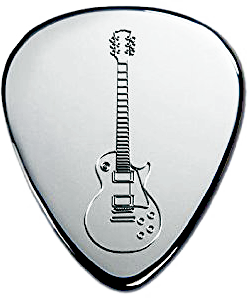
Playing guitar with a silver pick gives a unique, rich and bright sound, very different from normal plectrums (Brian May of Queen often plays with a silver sixpence) Silver guitar picks reflect bright tones with accentuated mids, that are produced in the experienced hands of an aggressive shredder. The low coefficient of friction gives these picks even more agility while string taps, glorious power scrapes, and slides liven up the music with rich dynamics.
Bronze - Metal
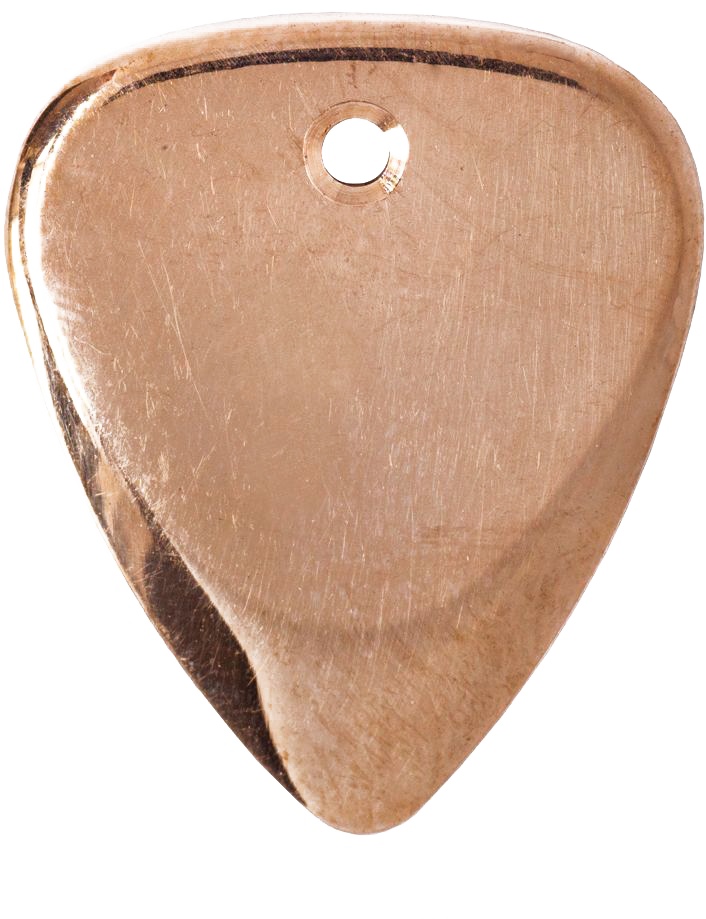
Bronze is one of the most commonly used metals for musical instruments. It is a mid hardness and mid weight metal and has a crisp powerful lower register and clear, bell-like treble register. Bronze picks offer a very bright tone with selective accentuation of mids and lower upper tones, thereby offering a unique sound profile.
Copper - Metal
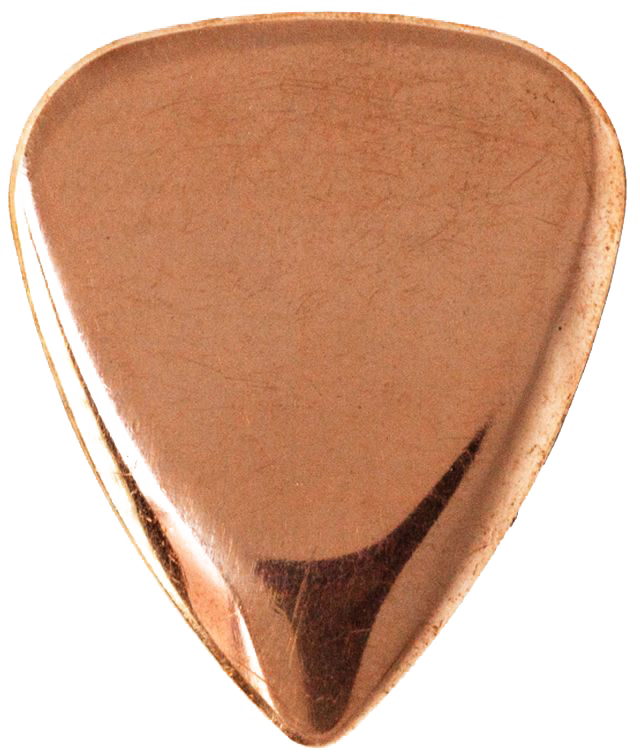
Copper is a soft metal and you can hear the impact when playing as it has slightly warmer tones than the other metals. Of all the picks, this pick is least durable; because it is a soft metal, it has the tendency to bend more easily, especially in a strong hand or grip; therefore a thicker gauge would probably be better suited.
Bone | Horn
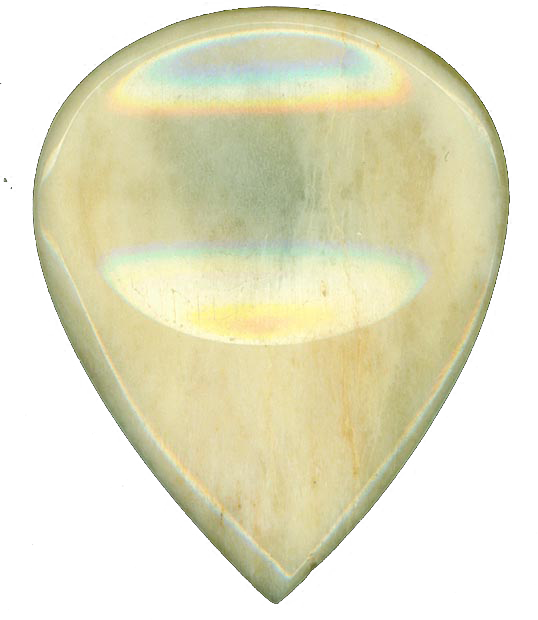
Buffalo Bone is a hard material that has clear crisp clean tones. Buffalo Horn has the closest tone to the fabled Tortoise shell picks as it is made from the same material, Keratin. Although softer than Bone it is still very hard wearing and has a more rounded mellow tone. They are manufactured from Vietnamese Water Buffalo Horn and Bone, which are bi-products from industries that produce Steak, Leather and Cheese. Buffalo Horn is slightly softer with much warmer tones and can be used for either Electric Guitar or Acoustic Guitar. Bone Tones are recommended for Acoustic Guitar, Electric Guitar, Gypsy Jazz Guitar & Archtop Jazz Guitar.
Glass
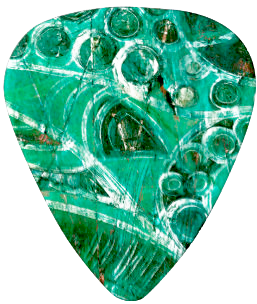
Glass is relatively hard and heavy in comparison to metal or plastic and therefore produces a greater range of tone. Glass can be polished to a smooth or rough texture depending on the grit of sandpaper used. Likewise, factors such as size, shape, and weight have a much more dramatic effect on the overall tone making each individual glass pick sound and feel unique. For flatpicking, glass is a great pick to try out, but because of a lack in flexibility, they are difficult to strum with.
Stone
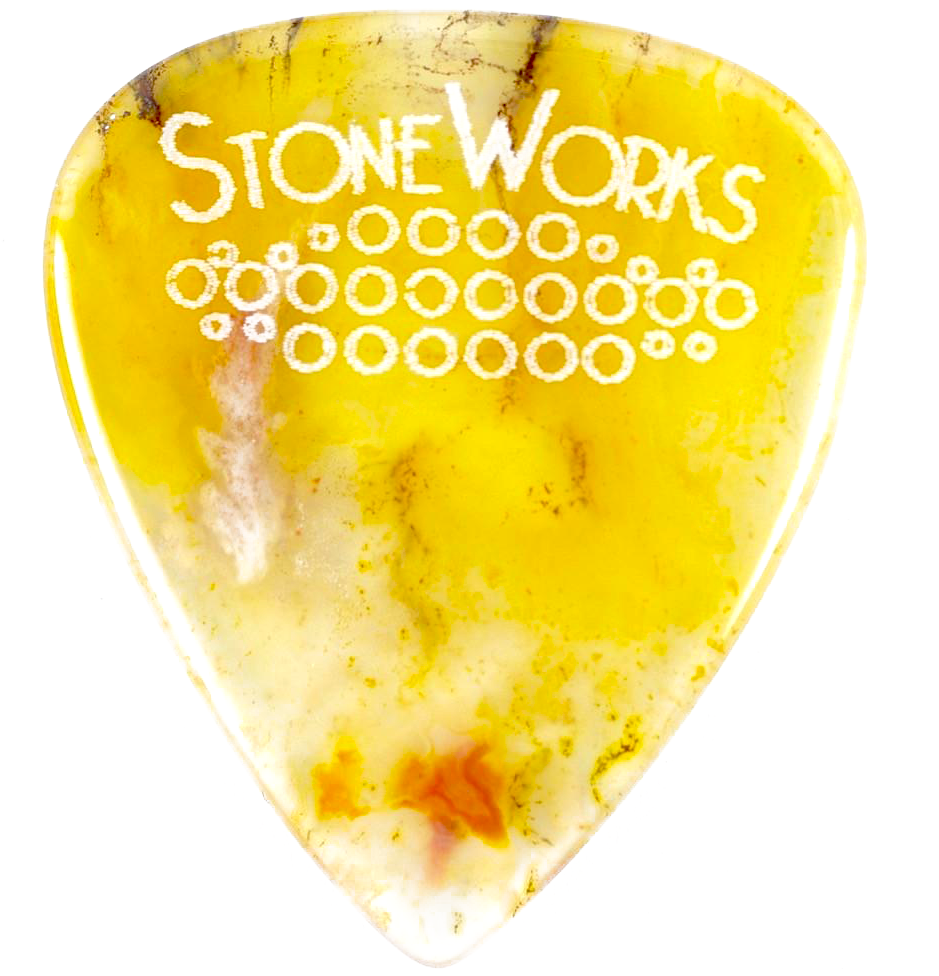
Stone picks have been described as warm, buttery and full bodied. The high polish creates an almost frictionless play. They are easy to grip and easily produce mid to upper range harmonics due to their density. Unlike plastic or composite pick materials, they don't absorb as many harmonics during the initial string attack, allowing for a potentially richer sound to be achieved.
Bloodwood - Wood
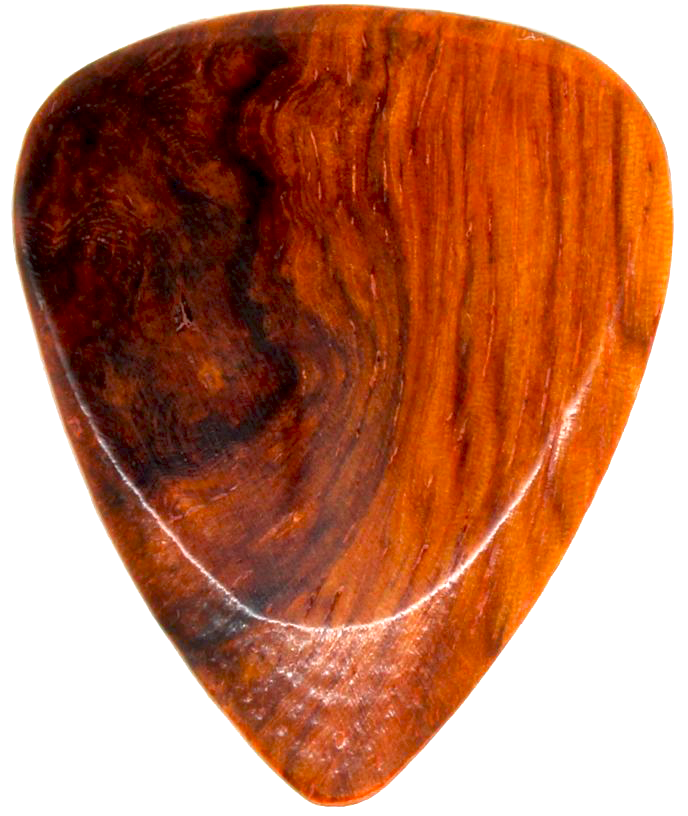
Bloodwood is a very hard timber, which polishes to a mirror like shine making it ideal for Electric Guitar. Recommended for Electric Guitar & Archtop Jazz Guitar. Wood picks produce a very rich-sounding warm tone with natural feel.
Ebony - Wood

Ebony is a close grained hard timber which gives a clean, crisp tone and is suitable for electric guitar. Its hardness ensures it can withstand the rigors of electric guitar playing and if used on an acoustic will definitely brighten up your sound.
Maple - Wood
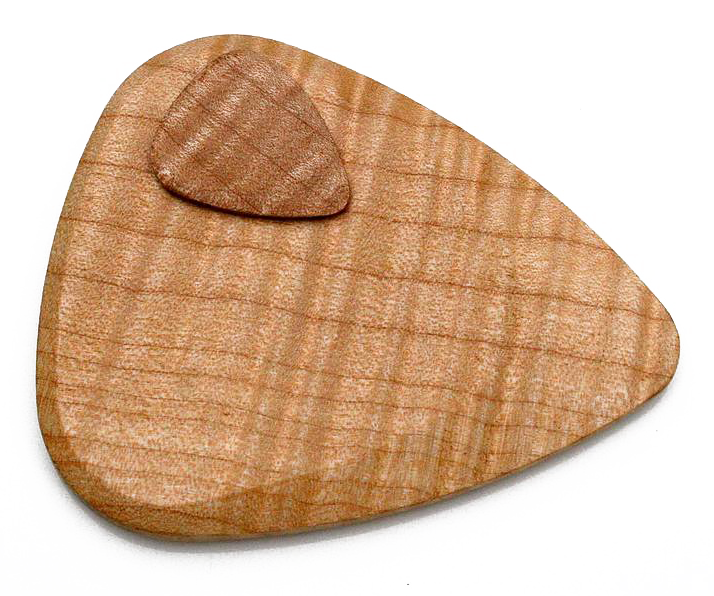
Maple is a relatively soft Timber which will evoke a good level of warmth to the tone of most Acoustic Guitars. Recommended for Acoustic Guitars & Archtop Jazz Guitars. Tames bright strings or treble-heavy guitars without affecting playability.
Burmese Rosewood - Wood
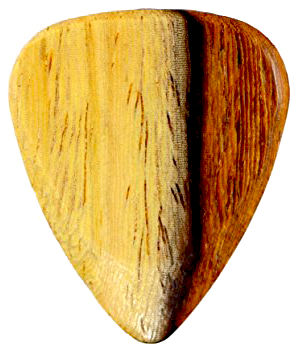
There is a variety of Rosewood picks on offer. Burmese Rosewood is a Mid softness Timber which gives a rounded mellow Tone. Burmese Rosewood Picks are rich-sounding wooden picks ideal for both electric and acoustic guitar playing.
Carbon Fibre
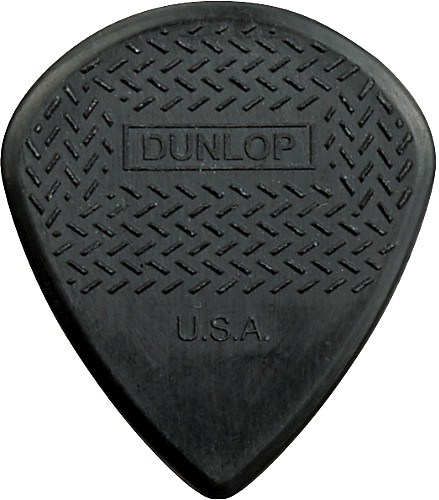
These picks are extremely durable and have an extremely high stiffness-to-weight ratio. The world's thinnest guitar pick is made from carbon fiber and has a thickness of 0.2 mm. Excellent for strumming chords! Carbon fibre is far more rigid than most traditional materials used for picks. Carbon fibre is also super light-weight, which combined with its strength is what has made it popular with performance car parts. This makes for a pick that is so light you can barely feel them in your hand.
PICK TIP & BEVEL (CONTOUR)
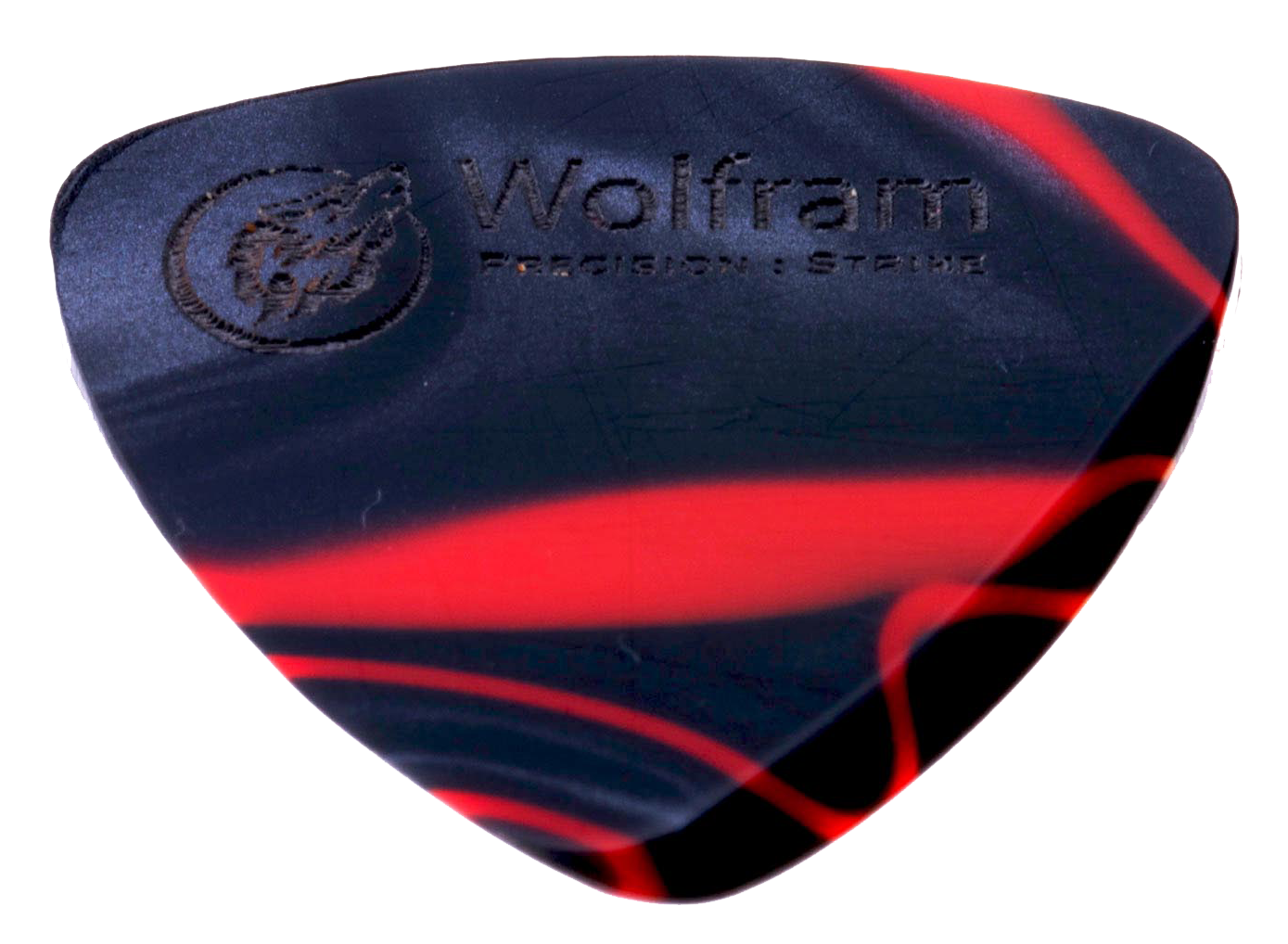
The pick tip & bevel is possibly more important to consider than shape, and it's because this defines the guitarists speed & style.
A bevelled edge affects the attack on strings which increases speed, while a sharper tip is easier to play lead lines and a rounded edge is preferred for strumming chords.
Thicker picks are generally more contoured, because a bevel reduces the degree to which the pick 'grips' the string, creating a surface for the string to glide off of.
PICK TECHNIQUES
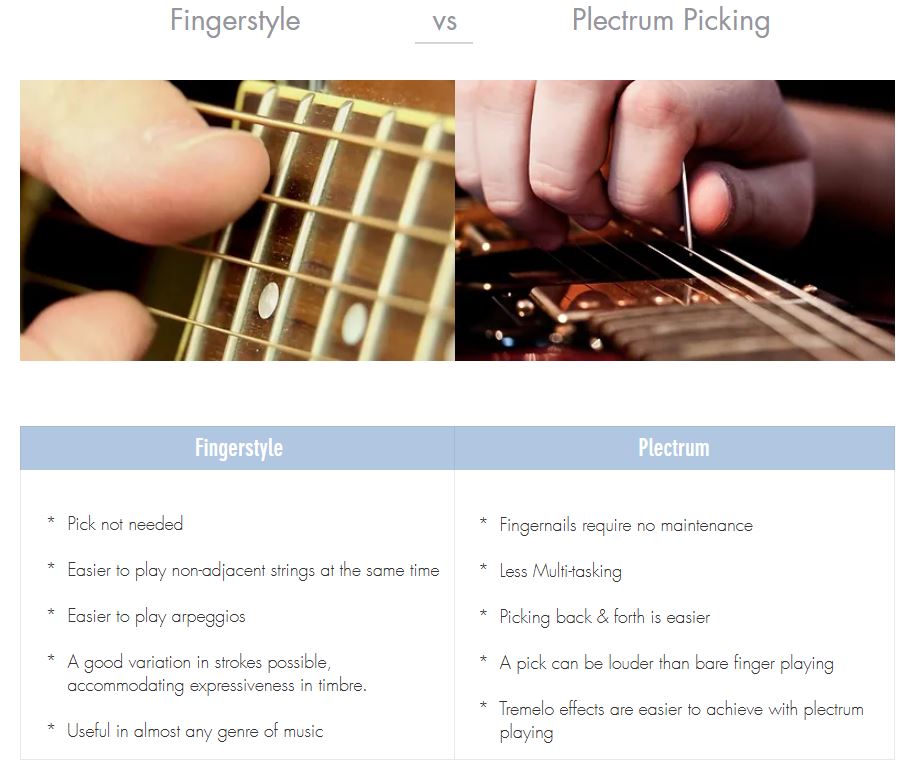
PLECTRUM | PICK PLAYING TECHNIQUES
LEAD
Flatpicking:
- This is a technique where the pick is held flatly between 2 or 3 fingers. Mainly used with steel string Acoustic guitars and generally played with Bluegrass & Old time country music.
Alternate Picking:
- Alternate picking is a guitar playing technique that consists of strictly alternating downward and upward picking strokes in a continuous run, and is the most common method of plectrum playing. If this technique is performed on a single note at a high speed, then it may also be referred to as tremolo picking.
Sweep Picking:
- Sweep picking involves a continuous 'sweep' with the pick across two or more strings (using down-strokes when moving down, and up-strokes when moving up), and is commonly associated with playing arpeggios. To produce a series of distinct notes requires that each note be fretted individually with the fretting hand, rather than held together as a chord.
Economy Picking:
- A combination of sweep picking and alternate picking, economy picking involves using alternate picking except when changing strings. In this case the guitarist changes to sweep picking, picking in the direction of travel: an upstroke if changing to a lower (pitch) string, a downstroke if changing to a higher (pitch) string.
Gypsy Picking:
- The picking technique of gypsy jazz has been described as similar to economy picking when changing from lower to higher strings, but performed with rest strokes. When changing from higher to lower strings, a down stroke is used instead of a sweep or economy stroke. For instance, on switching from the G to the B string, the plectrum moves in the same direction and comes to rest on the E string —though while switching from the B to G strings both strokes would be downward rest strokes.
RHYTHM
La Pompe:
- La Pompe is the rhythmic pattern used in gypsy jazz. This form of percussive rhythm is similar to the "boom-chick" in stride piano. The first beat is a staccato chord, emphasizing the lower strings with a more "bassy" sound, produced by a downstroke; the fretting hand immediately afterward releases the strings slightly to deaden them. The next beat is a percussive strum, produced by a down stroke, that emphasizes a more "trebly" sound by engaging a fuller range of the strings. Various artists prefer different levels of staccato on beats 1 and 3, and beats 2 and 4, but in general both beats are short, but still voiced to some degree. The pattern then repeats, but before every first and third beat, an upstroke is performed very quickly (typically with the strings still deadened), giving the music its heavy swing feel.OTHERS
Anchoring:
- Anchoring is a practice in both fingerstyle and plectrum where part of the picking hand, usually the little finger or "pinky" touches the guitar body. Although anchoring is common, many guitar teachers advise against it as it limits flexible hand movement.
Hybrid Picking:
- Hybrid picking is mixture of plectrum picking and finger picking. Normally the player holds the pick with thumb and index finger, picking the string, and utilizing the middle and ring finger to finger pick adjacent strings.
Tapping:
- Tapping is a guitar playing technique, where a string is fretted and set into vibration as part of a single motion of being pushed onto the fretboard, as opposed to the standard technique being fretted with one hand and picked with the other.



